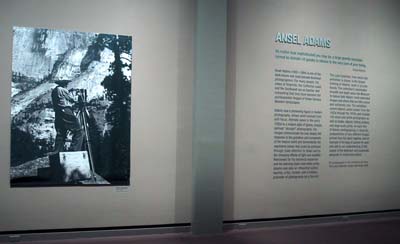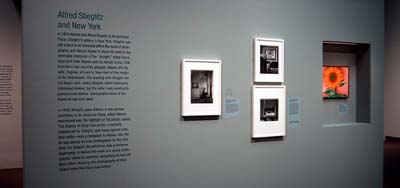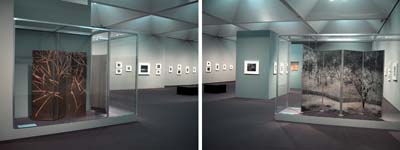
| TODAY |
| Lectures |
| Workshops |
| Gear & Gadgets |
| Destinations |
| Cruises |
| Airfare |
| Specials |
| Unaccompanied Minors |
| Carolyn's World |
| Contact Us |
| Destinations... |
||
When we first entered the exhibit, we were greeted with a rare look at some of Ansel Adams early works... some as far back as 1919. They were described as "painterly" by Karen Haas, the MFA curator of The Lane Collection. These photos were interesting as a contrast to what most of us have come to associate with an Ansel Adams photograph... sharp focus, extreme details, and amazing light.
We all know Adams loved the outdoors, this exhibit showed us how early this love blossomed. There were many examples of his work from the 1920s... including some rare Sierra Club photos of Yosemities, the Rockies, and the famous Half Dome. Most of these places Adams would return to and photograph over his lifetime.
In the 1930s, Adams became involved with a group of Bay Area photographers called Group f/64, experimenting with large format cameras. No more soft focus from that point on... the small aperture meant exacting sharpness and light. There were other interesting bits and pieces to get the exhibit goer closer to Adams... videos, timelines, commerical work, etc.
The layout of the exhibit flowed nicely from one decade to the next, highlighting the incredible productivity of Ansel Adams. Adams was a great technical photographer and frequently lectured on his "zone system" of shooting. He also wrote many books on the subject, some of which are were on display in this exhibit.
In the 1930s and 1940s, Ansel Adams did a lot of traveling in the American Southwest. With its dramatic light and grand vistas, Adams created some of his most iconic works.
There were also many dramatic "pairings" in the gallery, like the two different size prints of Half Dome in the beginning of the exhibit or in the photo above of MFA's own O'Keeffe and an Adams' image with the same painting in its original frame. However, none was as exciting as seeing three large screens of Ansel Adams images near the end. Click here to see a panorama of the screen exhibit. These screens are extremely rare (...less than 10 in existence?). Adams created these screens as gifts for his friends. To see three of them in one show was just incredible!
The photographs at the end of the show was just as interesting as the ones in the beginning. It showed the same subjects Adams had shot all his life, but now with a much different eye...they were not so much "abstracts", but more as Adams like to refer to them, "extracts" of things he saw around him. I don't remember the source of this quote, but someone once said "...it's nice to know we have an Ansel Adams running around somewhere in this world...". We at RainyDayMagazine couldn't have agreed more! |
MFA Ansel Adams |
|
The Ansel Adams Exhibition opens on August 21 (this Sunday) at the MFA. This exhibit, sponsored by RBC Dain Rauscher, features a wide range of Adam's photographs from the Lane Collection. RainyDayMagazine got a first hand look of this amazing exhibit this week. As Saundra Lane said at the preview..."This is an exhibit I've been waiting 30 years for and it's now finally here!". After going through the show, we had a chance to chat with Saundra Lane about her impressions of Ansel Adams. She thought, had he been alive today, he would have been a big fan of digital photography, especially with digital's ability to manipulate tone and contrast. Adams himself, trained as a classical pianist, had always view the negative as the "score" and the print as the "performance". With his ability to "pre-visualize" how he wanted his final output, Adams would have loved being able to do the equivalent of the darkroom "dodging and burning" in creating his images in the digital domain. The exhibit will be at the MFA until the end of December. We urge you to go on Sunday and go back often... there is so much in the photographs that one cannot possibly see everything in one visit.
Other MFA Reviews: - Yachts - Speed
|
||











